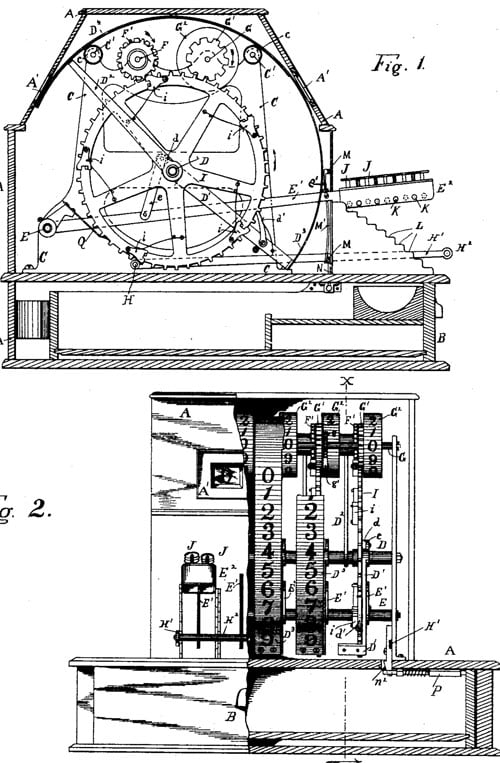Who Was Melvin Lovell?
Born in Pennsylvania in August 1844, Melvin Lovell was a successful businessman and woodenware manufacturer who also held several patents for multiple devices during his lifetime. A few of the patents he held included the patent for cash registers, otherwise regarded as adding machines.
Early Life
Melvin Newton Lovell was born in Allegheny, Venango county, Pennsylvania, on 31 August 1844 to natives of Pennsylvania, Darius T. Lovell, and Susan B. Lovell. Melvin had two younger sisters: Minerva, born in 1850, and Mary, born in 1854.
Melvin’s family migrated to Kerrtown, a village located in the vicinity of Titusville, PA, when he was a boy. At Kerrtown, Melvin continued to grow, studying at the local common schools. He also served as an apprenticeship in the carpenter’s trade, with his natural mechanical talent helping him become a skilled workman in no time.
Melvin Lovell continued his carpenter trade most of the time he was at Kerrtown before becoming interested in the oil fields of Titusville.
Career
Phase 1
Phase 2
Melvin Lovell returned to his residence in Erie in 1865, where he worked in the carpenter’s trade for a number of years thereafter before his death.
What Is Melvin Lovell Known For?
Invention 1
Melvin became the first and most potent factor in securing the proper representation of the state of Pennsylvania at the Cotton States Exposition, held in Atlanta, Georgia in 1895. He was subsequently appointed commissioner from Pennsylvania to that exposition, where he did enthusiastic and particularly successful work on behalf of his native state.
Invention 2
Melvin Lovell started to manufacture his other patents, such as spring beds, alone in 1881. Manufacturing under the Lovell Manufacturing Company, Melvin grew the company into one of the largest manufacturing firms at that time. Lovell Manufacturing Company was also recognized as the most extensive manufactory of clothes-wringers in the entire world.
Melvin also founded Lovell Stores, a sales agency for his products, to aid distribution across the entire country.
Invention 3
Melvin’s first patent for cash register and indicator (US445959) was granted in 1891.
The operation of the machine will be as follows: Let’s suppose that the operator wishes to record a sale amounting to $12.56. He may do it by pressing key 1 on the left-hand lever, key 2 on the next level to the right, key 5 on the next level to the right, and key 6 on the right-hand lever, or he may work from right to left, or he may follow no successive action, the result will be the same — the indicators will display at the openings A’ in the case the figures 1 2 5 6, and on the drums inside the figures 1 2 5 6 will be on the reading-line.
The operator will then depress the bar, which will release the levers E’, and they will all resume their normal position, the indicators will all show naughts at the openings A’; but the drums ( in this case will stand, as above stated, with the figures 1 2 5 6 inline. If the next sale to be recorded should be $13.04, the drums would be moved so as to read 2 6 2 0, which is the sum of 1 2 5 6 and 1 3 6 4, while the indicators would show at the openings A’ the figures 1 3 6 4, the amount of the last sale recorded.

Melvin Lovell: Marriage, Divorce, Children, and Personal Life
Marriage
Melvin Lovell married Elizabeth A. Nelson, the daughter of James and Mary A. (Gaggin) Neilson, in 1870.
Children
Melvin and Elizabeth had two children together. Susan Mary, the first daughter, was born in 1868, two years before they were legally married. Bertha Neilson, the second daughter, was born in 1876.
Tragedy
Melvin lost his first daughter in 1888 when she was only 20 years. Melvin Lovell died in 1895, aged 51.
Melvin Lovell: Awards and Achievements
Award 1
Lovell was one of the organizers and stockholders of the Combination Roll & Rubber Manufacturing Co., of New York, which was formed for the purpose of manufacturing his patents, with headquarters in New York and a factory at Bloomfield, New Jersey.
Award 2
Melvin Lovell became the first and most potent factor in securing the proper representation of the state of Pennsylvania at the Cotton States Exposition, held in Atlanta, Georgia in 1895. There, he was appointed commissioner from Pennsylvania to that exposition, where he did an enthusiastic and particularly successful work on behalf of his native state.
Melvin Lovell’s Contemporaries
During the latter half of the 1800’s Melvin Lovell’s fellow inventors engineered a staggering number of innovations, including:
- 1858: The internal combustion engine was invented by Jean Lenoir
- 1862: The machine gun was invented by Dr. Richard Gatling.
- 1862: The first manmade plastic was invented by Alexander Parkes.
- 1866: Alfred Nobel invented dynamite.
- 1867: The first practice typewriter was invented by Christopher Scholes.
- 1868: Traffic lights were invented by JP Knight.
- 1876: Alexander Graham Bell patented the telephone.
- 1876: The carpet sweeper was patented by Melville Bissell.
- 1877: Thomas Edison invented the cylinder phonograph.
- 1877: Moving pictures were invented by Eadweard Muybridge.
- 1884: James Ritter invented the first mechanical cash register.
- 1886: Gottlieb Daimler invented the first four-wheeled motorized vehicle.
- And, just for fun… In 1886 Coca Cola was invented by John Pemberton.